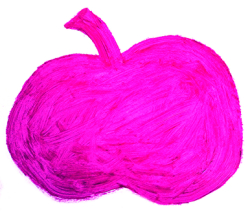Sophie Petit
The artist grew up in West Berlin, which she describes as a small island occupied by the British, American and French armies, in the middle of a communist ocean. A city with its own rules and rights where people were anti-fascist, but also anti-communist, against war in general and against nuclear energy, for everything organic and for cultural diversity. A city where money and fashion, except maybe the eccentric, were unimportant and therefore rather unexistant and where the non plus ultra look of any teenager was a pair of holed Levis jeans and a hoodie bought in a second hand store.
In Berlin graffiti and the public expression that it embodies was to be seen basically everywhere and the beautyfully coloured U-Bahn trains considered vandalism and not art. The city, cut in two, was full of abandoned places, of tracks that led nowhere, closed train stations, of blind alleys and houses that were just simlpy cut off. An Eldorado for taggers. These visible images of a brutal separation will forever mark the mind of the artist, who revolts against boundaries and barriers created by man against man. An injustice without explanation. A game of luck.
The city was full of walls with tags and sprayed love messages, but the Berlin Wall was the first great quality graffiti support. And this one was impressive. The West Berlin of the 80's, with it's punks and goth's, hard rock music and neon colors, policemen in the West in green uniforms called Bullen (bulls). The East with it's heavily stone bleached jeans, the Trabant, the Folkpolice called "Vopos" and the Stasi. Communism or capitalism was public enemy no. 1 depending one which side of the wall one was living.
A world where Western tourists watched from a tower erected near the Brandenburg Gate the East Germans as if they were exotic animals in the Zoo. A total ban on crossing the border for some and for the others, border controls that could last endless hours with a transpercing look of the "Vopo" into your eyes going straight to your guts. Highways in the transit zone were limited to 100km /h, and between the large concrete slabs the rubber seals created a memorable and inseparable sound of the transit through the East ...daDum...daDum...daDum. Today this would probably be classed as a meditative sound. At the time it was keeping you alert.
After the fall of the wall the artist spends her time in the squats that arise everywhere in the former East Berlin. Galleries that are open to everyone, with sculpture gardens created in common and artistic works of any type in these large abandoned areas: film, video, installation, painting, sculpture, dance and theater.
An artistic exchange with no barriers, no notion of class difference or background. This was accompanied by a thriving electronic music scene that occupied the old cellars and bunkers or the streets with, for example, the 'Love Parade'or the 'Carnival of Cultures', where different cultures of the world parade with their music, their dances and colorful costumes.
She continues her discovery of cultures thanks to numerous travels on the five continents. During her last long trip that took her to the Middle East, Oceania and South America, she went on a discovery to see how artists share their ideas and dentity in their urban or rural surroundings. She was struck by the explosion and the beauty of urban art in cities like Tel Aviv, Melbourne, Auckland, Montevideo and Rio de Janeiro. She did a photo documentary to gather these images sometimes just decorative, sometimes sublime, sometimes provocative, humorous, ironic or politic. Especially Buenos Aires had a prolific diversity of expression in the street. She spent more time there and met artists who taught her the stenceling and passed on their love of urban expression. Art as a get-together, the human inherent need to express and share.
Even if the artist shares provocative or political ideas in some of her projects, she emphasizes not to feel the need to shock by the ugly or scary, sometimes needed to be taken seriously on these issues in the art world. She explicitly takes the opposite path by trying to touch the viewer with gentleness that leads to reflection and reverie. The dream, a world synonymous with freedom, without codes / obstacles or barriers and without preconceived ideas.

